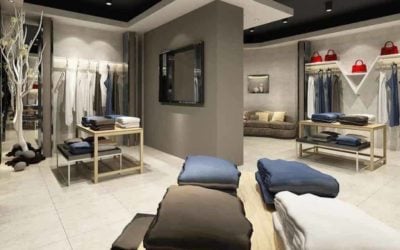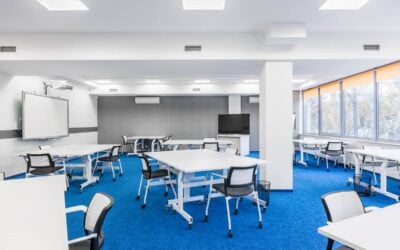How Light Impacts Psychology & Mood in Retail
Human behavior is influenced by a seemingly infinite number of external factors. Sometimes we’re not even consciously aware of what’s causing our specific reaction or response. Our subconscious minds automatically react to sensory cues all around us – music, scents, colors, and other subtle triggers that produce positive, negative, or neutral emotions and actions.
Light is one of those elusive elements that influences how we react to certain settings and situations. Not only does light create visual effects, it also has biological and psychological effects that impact our mood, emotions, and behaviors. For example, have you ever been at a shopping mall and felt compelled to go into a store, but you didn’t know why? Maybe it was the window display, or colorful promotional signage, or how the lighting was directed. It was most likely a combination of subtle tactics working together to lure you in – with strategically planned lighting subliminally setting the mood for your shopping spree.
How Light Impacts Psychology & Mood in Retail
Decades ago, retailers thought lighting’s sole purpose was to illuminate store aisles so customers could see merchandise better. Of course lighting still serves that obvious function today, in addition to less noticeable tasks that are intended to influence people’s emotions. Nowadays, well-planned store lighting systems are designed to create an aesthetically pleasing shopping environment that attracts a higher volume of repeat customers. Lighting sets the overall mood within a store or showroom. It generates an emotional connection with shoppers, and helps build brand loyalty.
If you are a retailer, you want customers to enjoy shopping in your store. Happy and satisfied customers shop longer and typically spend more money when they’re checking out. If updating your store’s lighting plan will make the space look and feel more appealing and inviting, it is well worth the investment. Current research shows that retail lighting does influence consumer attitudes and behavior, even in its most subtle applications. A poorly lit store is simply bad for business, while a well lit store stays profitable since it has gained the support and trust of loyal customers.
Functions of Lighting in Retail
Contractors and lighting designers have a lot to consider when they start planning a lighting layout for a store or showroom. Numerous factors influence what will be the best retail lighting system for a specific establishment. Size of the space, product selection, merchandising fixtures, customer demographics and code requirements all need to be addressed during the planning process.
Lighting typically varies a great deal for different retailers. A lighting plan that works well for a big-box grocery chain would not be effective or sensible for a luxury clothing store. However, there are a few basic functionality tips and general lighting rules that do apply across the board. Following these simple strategies can help maximize profits and keep customers coming back.
Invest in LED
Retailers have four main choices when deciding what types of lights to use in their new or updated lighting plan – incandescent, halogen, fluorescent, and LED. We guarantee almost every individual in the professional lighting industry would recommend LED.
Even though LEDs may cost more initially, they’re the better choice for long-term budgets. The price paid upfront will return quickly, due to lower energy bills and fewer maintenance fees. In addition to being long-lasting and energy efficient, LED lights are also the most versatile. They’re ideal for display, ambient, task, accent lighting, and virtually every fixture style used in retail.
Color Temperature
The best and most effective retail lighting has to create a comfortable, yet shoppable, store environment for its customers. Aesthetically pleasing levels of comfort are dependent upon the right balance of color temperature. Correlated color temperature, or CCT, is measured in Kelvin (K) units, and indicates how warm or cool white light appears to the human eye.
Different color temperatures are appropriate for different retail environments and situations. Warmer light creates a relaxing and inviting atmosphere, which is beneficial for stores selling clothing, linens, and furniture. Cooler light evokes a feeling of cleanliness and spaciousness, which is ideal for stores that carry home appliances, electronics, and hardware.
Just be careful not to overdo it with one extreme temperature range. Lighting that is too warm may make customers feel tired or simply too relaxed to make product-buying decisions. On the flip side, lighting that ranges too cool may have an anxiety-inducing effect on some customers, along with producing a cold, sterile atmosphere within the space.
Quite often the best solution is to have a customized mix of warm and cool lighting throughout one space. General overhead lighting may be suitable at a neutral temperature, while window displays and dressing rooms could benefit from lighting that ranges either warmer or cooler.
Layers of Light
The right lighting in retail settings creates an inviting ambiance while clearly showcasing products and displays. To properly achieve this, lighting designers recommend using layers of lighting within a store space. A strategic balance of ambient, task, and accent lighting is vital for all lighting designs, including retail lighting systems.
Here are the primary functions of these three different lighting types:
Ambient Lighting: Provides general lighting throughout the retail space, usually from a variety of overhead fixture styles.
Task Lighting: Adds functionality to work spaces, such as checkout counters, customer service desks, and consultation areas. These lights include desk lamps, pendants, and suspended hanging lights.
Accent Lighting: Gives visual interest to displays, and directs shoppers’ eyes from product to product. Spotlights, track lights, and dimmable fixtures provide this functionality.
Impacting Mood in Retail
Finding that perfect balance of pleasant atmosphere and proper illumination can seem challenging. This is why having the expertise and knowledge of a lighting design team is always an advantage. They can configure a lighting plan that will enhance customer experience while creating the perfect feel-good mood within any space.
Research expert, Dr. John Flynn, was one of the first individuals to recognize how light goes beyond its functional purpose of illumination, and can influence people’s emotions and feelings. Decades ago, he identified four lighting attributes – bright/dim, uniform/non-uniform, central/perimeter, and warm/cool. Designers still refer to these attributes today to create well balanced, mood enhancing lighting designs for retail clients.
Here are some ways lighting design psychologically influences consumer attitudes, which consequently benefits retailers:
Improves Product Appeal
The right combination of lighting can improve the overall appeal of virtually any merchandise category. Professional lighting designers use a variety of simple, no-fail techniques to accentuate window displays, shelved product, in-line displays and more. These helpful lighting tricks all have the intended goal of elevating brand perception among customers.
Spot lighting, dimmable track lights, and utilizing different color temperatures are all common methods of generating visual interest for particular products. When shoppers see your merchandise in a new and better light, they’ll be more likely to make a purchase and become long-term customers.
Directs Customers Naturally
Once customers enter your store or showroom, lighting does the job of directing them around the space. Overhead lighting acts as the main guide down aisleways. Accent lighting that’s focused on product displays gains the interest of shoppers.
People are naturally drawn to light and well-lit areas. So if lighting is directed on merchandise, it has the subtle intention of making customers stop, shop, and hopefully buy. Lighting also has the purpose of helping customers differentiate between areas of the retail space. This is where the use of ambient versus accent lighting plays a vital role.
According to recent studies, people have a tendency to gravitate toward areas with a contrast of lighting intensities, such as a combination of bright and dim. Areas featuring just one lighting intensity evoke less interest among shoppers. Cooler, blue-spectrum light has a somewhat energizing effect on shoppers, while warmer lighting temperatures make customers browse longer within an area. Once again, the best retail lighting solution may rely on finding the ideal balance of all these unique attributes.
Builds Trust & Positive Emotions
When customers enter your store or showroom, you want the lighting to generate feelings of comfort and positivity. And when it comes to building trust, retail lighting should show products clearly and accurately so customers can see colors and quality at their most genuine. Allowing shoppers to see merchandise in its most authentic state is one of the best ways to build trust and gain more customers. This is where the lighting term Color Rendering Index, or CRI, is important to know. CRI measures light’s ability to reveal the true colors of an object. Lights with CRI ratings of 80 or above are optimal, since colors look true to tone and vibrant.
Without a doubt, lighting has an emotional effect on people. That’s why a retail store’s lighting plan needs to align with the intended atmosphere – lively or relaxed – and the types of products being sold – upscale or value. If you are a clothing retailer that has dressing rooms in your store, it’s crucial for business to pay close attention to lighting direction and temperature within each dressing room. Buying new clothing can be an emotion-fueled process. And you want customers to see what they’re trying on in the most flattering light.
TCP Lighting in Retail
The importance of lighting in retail settings is often overlooked, but it’s actually one of the most important and effective tools for creating the right mood and enhancing overall sales. Every retail space has its own unique set of needs. For this reason, it’s best to work with the lighting experts at TCP. They understand how lighting affects retail sales and can offer the best lighting solutions for your specific retail space.
TCP manufactures high-quality LED lighting systems that are long lasting, energy-efficient, and environmentally friendly. If you’re looking to improve business, enhance your brand, and save money in the long run, investing in LED lighting is the way to go. When in your store, customers will notice the subtle lighting differences, and they’ll enjoy a better shopping experience.
Want to know more? Discover how TCP can bring your best retail lighting plan to life. Click here for details.







